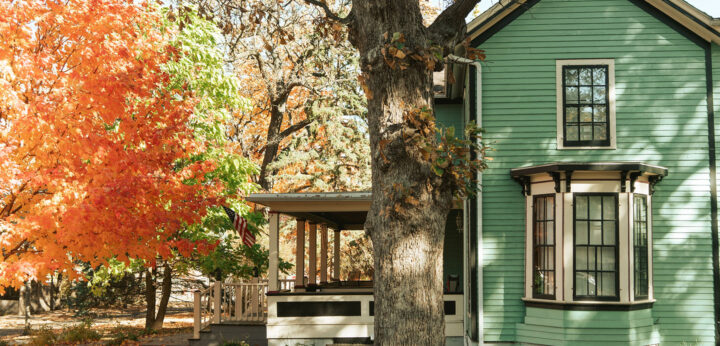Table of Contents
Wondering how renting a house works? You’re in good company. The market for single-family home rentals is booming due to how expensive it is to buy a home now — something you may be painfully aware of.
The good news is that the process for renting a house is similar to that of renting an apartment. However, there are a few things you should bear in mind, which we cover below.
Tip 1: Check whether you meet the requirements to rent a house
Before a landlord will rent you a house, they’ll want some evidence that you’ll be able to pay your rent. For this reason, each will have their own income and job requirements for prospective tenants.
Income and job requirements
Some smaller landlords may not have any income or job requirements, but many prefer to rent to people whose living expenses (e.g. rent and bills) don’t exceed a certain percentage of their income (often around 33%). This is known as the “3 times the rent” rule that landlords commonly use to screen potential tenants.
If you’ve got a steady job, then providing evidence that you meet these requirements will be relatively straightforward. If you’re self-employed, retired, or between jobs, then you might have to find other forms of documentation.
You may be asked to provide two or three documents in total, which can include
- Bank statements
- Pay stubs
- Your W-2 income statement
- IRS tax forms (e.g., W-2, 1099-MISC, or IRS 1040)
- Other documents/letters proving your income
What to do if you don’t meet these requirements
If you’ve found the perfect home but you don’t meet the landlord’s income and job requirements, then don’t give up hope. Your landlord may still be willing to rent to you if you can show that you’ll make reliable payments. The following are some steps you can take to change their mind:
- First, check how strict these requirements are. Tell the landlord where you fall short of the requirements and explain that you can show that you’ll be a reliable tenant.
- Showcase whatever financial advantages you have, such as a full savings account or no debt.
- If you have ample savings but no current source of income, then offer to pay more upfront.
- If you’re currently paying a similar amount of rent, then use your rental contract as evidence that you’ll be able to continue paying that amount in the future.
- Find a guarantor who has good credit and a high income (bear in mind that they will be responsible for your rent if you can’t pay).
Credit requirements
There is no set credit score requirement for renting a house, but the landlord may conduct a background or credit check before agreeing to rent the property to you. You’re entitled to a free credit report once a year from each of the three main credit bureaus (available from annualcreditreport.com), so you can check your credit before filing your application. Your bank or credit card company might also provide your FICO score for free.
Landlords who run a credit check are usually looking to see a minimum credit score in the range of 620–650, but they’ll also be interested in other information on your credit report, such as your rental history and whether you typically pay bills on time.
Tip 2: Determine your budget for rent, utilities, and more
Although the “3 times your rent” rule mentioned earlier should be taken as a general rule of thumb (and is no longer necessarily applicable to everyone), it can be a useful starting point for calculating your rental budget.
Adjust this number according to your circumstances. If you’re good at keeping your other costs to a minimum, then you could look for a house with rent closer to half of your income, whereas if you have a lot of additional monthly expenses, then you might rent a home that costs closer to one-quarter of your monthly income.
When calculating your budget, make sure to factor in these additional costs that you may need to pay upfront:
- Application fee
- A security deposit
- Your first (and maybe last) month’s rent
- Moving fees
- Cost of furniture/appliances
Understand the cost of renting a house
Take into account that you may also need to pay fees in addition to your monthly rent, such as
- Utility bills
- Cost of damages you cause to the property (and repairs specified in the lease agreement), although these may come out of your security deposit
- Buying equipment for maintenance (e.g. lawnmower or landscaping equipment)
- Service costs (e.g. garbage collection, telephone/cable)
Tip 3: Decide on what features and amenities your home needs
The first thing you should do is differentiate between negotiable and non-negotiable requirements that you have for your house. One of the most basic (and important) points to consider is location. This includes
- What the neighborhood is like
- Proximity to your workplace, schools, parks, hospitals, or other important places
- Proximity to neighbors, highways, or potential sources of noise
- Access to public transport
Also consider whether you want features that not every home has, such as
- Outdoor space (e.g. a patio, garden area, or yard for a pet)
- Multiple bedrooms for children, a home office, or other uses
- Storage space
- Specific appliances
- Off-street parking
- Other features such as a large kitchen, multiple (or en-suite) bathrooms, or a fireplace
You should also decide on a lease duration, taking into account the fact that landlords tend to prefer renting to tenants for longer periods to avoid having to pay fees associated with preparing for and finding new tenants.
When it comes to renting a house, there are also different types of lease agreements that you can consider, such as rent-to-own and lease purchase agreements. You can explore these options if you’re sure you’ll want to live in the area for the foreseeable future.
Tip 4: Browse listings and visit houses
You have several options when searching for a property:
- Browsing rental sites
- Using a real estate app
- Combing through newspaper listings
- Hiring a real estate agent
The benefit of hiring a realtor is that they can help you narrow your search, arrange viewings, and explain the terms of your lease. The downside is that they will charge you a realtor fee. We recommend starting your search on your own, and hiring an agent later if you have trouble.
Timing your search
You should begin looking for a home around 1-2 months before your ideal move-in date. The goal is to give yourself enough time to compare houses without starting your search so early that the landlord will overlook you in favor of someone who’s ready to move in.
Viewing houses
It’s a good idea to view a few houses so that you can compare them and feel confident that you’ve made the right choice. Once you’ve found a place you like, resist the urge to make a commitment before you’ve seen it in person. While it may seem unlikely that the house will be wildly different from how it’s advertised, the risk isn’t worth taking.
Tip 5: Review, negotiate, and sign your lease
Landlord–tenant law varies by state, but your rental lease agreement will contain most of what you need to know regarding your respective responsibilities. Key points to look out for in your rental contract:
- Who’s responsible for maintenance/repairs
- How much notice the landlord is obligated to give before visiting the property
- Details on rent payments (amount, due date, and grace period)
- Remodeling restrictions
- Occupant/visitor restrictions
- Whether subletting is permitted
- Terms and conditions of terminating/renewing the agreement
Some of these terms may be negotiable. If there’s anything in the contract that makes you feel uneasy, then don’t hesitate to speak up or ask questions. If you chose to hire a real estate agent, then they should look over the lease agreement and identify any potential problems.
Signing your lease
You can generally sign your lease agreement online or in person. Signing it in person is often the best approach because it means that someone will be there who can answer any questions you may have.
Signing the lease agreement is the final step in the process of renting a house. You and your landlord should each receive a copy of the lease agreement for safekeeping.






